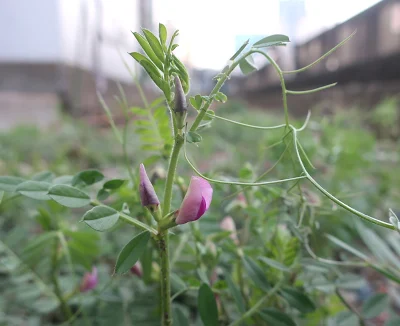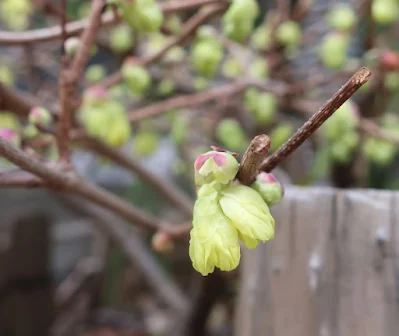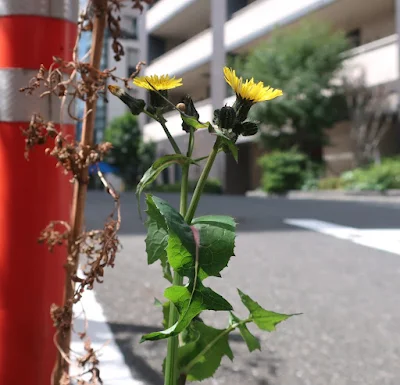It was a pleasant surprise to find two Japanese camellia trees both of which had pink and variegated blooms on the same tree (3rd and 6th photos). The pink ones on these trees are alike while the variegated ones are quite different. (Compare those in the 1st and 4th photos.)
Hi! I'm Kei Narujima. This is a blog about flowers/plants🌼and bugs🐛, and sometimes art and unique Japanese culture that make you smile or think (or so I hope)!! こんにちは。花や虫、そして時々日本の文化などについて書いてます😊。税務英語については https://zeimueigo.blogspot.com/ をご覧ください。
Variegated Camellias 斑入り椿
英語の後に日本語が続きます。
It was a pleasant surprise to find two Japanese camellia trees both of which had pink and variegated blooms on the same tree (3rd and 6th photos). The pink ones on these trees are alike while the variegated ones are quite different. (Compare those in the 1st and 4th photos.)
It was a pleasant surprise to find two Japanese camellia trees both of which had pink and variegated blooms on the same tree (3rd and 6th photos). The pink ones on these trees are alike while the variegated ones are quite different. (Compare those in the 1st and 4th photos.)
Oshima Cherry Blossoms (Prunus Speciosa) 大島桜(オオシマザクラ)
英語の後に日本語が続きます。
There are a variety of cherry blossoms and the king of them is Somei Yoshino, but Oshima cherry blossoms (Prunus speciosa) are not bad, i.e., as beautiful as, and more gorgeous than, Somei Yoshino cherry blossoms, aren't they?
There are a variety of cherry blossoms and the king of them is Somei Yoshino, but Oshima cherry blossoms (Prunus speciosa) are not bad, i.e., as beautiful as, and more gorgeous than, Somei Yoshino cherry blossoms, aren't they?
Unlike Somei Yoshino cherry blossoms, which are pinkish white, Oshima cherry blossoms are whitish pink at first, then turn to baby pink. Another difference between Oshima and Somei Yoshino is that Oshima cherry trees produce blossoms and leaves at the same time (as you can see in these photos) while Somei Yoshino produces blossoms first and then leaves after blossoms fall.
Flowering Peach (Prunus Persica Hanamomo) ハナモモ(花桃)
英語の後に日本語が続きます。
I bumped into these trees on my way to see cherry blossoms. They're flowering peach (Prunus persica Hanamomo). Finding the pinkish red (1st photo) and baby pink (2nd photo) blooms, which are larger than cherry blossoms, were a pleasant surprise to me, who hadn't taken an early morning walk for the last two days because of Asian dust covering Japan.
The Hanamomo flowering peach is native to China but has been improved in Japan to produce more flowers since the Edo period (1603 to 1868). The term "hanamomo" translates to "flower peach" in English. Unusually, the English and Japanese names coincide.
 |
| 2025/3/27 |
 |
| 2025/3/27 |
 |
| 2025/3/27 |
Buttercup Witch Hazel (Corylopsis Pauciflora) ヒュウガミズキ(日向水木)
英語の後に日本語が続きます。
I look down while walking these days to find spring flowering plants and this is one of them, buttercup witch hazel or winter hazel (Corylopsis pauciflora). The witch hazel tree is 20 - 30 cm tall, much smaller than the spike winter hazel tree I saw early this month.
I look down while walking these days to find spring flowering plants and this is one of them, buttercup witch hazel or winter hazel (Corylopsis pauciflora). The witch hazel tree is 20 - 30 cm tall, much smaller than the spike winter hazel tree I saw early this month.
Buttercup witch hazel resembles spike winter hazel, but the former produces a cluster of 1 to 3 flowers while the latter's cluster consists of 5 to 10 flowers.
Carolina Cranesbill (Geranium Carolinianum) アメリカフウロ(亜米利加風露)
英語の後に日本語が続きます。
It was very warm last weekend, which has accelerated the blooming of small plants like this one, i.e., Carolina cranesbill (Geranium carolinianum). Carolina cranesbill flowers are so tiny (1 cm in diameter) and lovely that no one can expect it to produce such funnily devil shaped fruits (2nd and last photos), don't you think?
It was very warm last weekend, which has accelerated the blooming of small plants like this one, i.e., Carolina cranesbill (Geranium carolinianum). Carolina cranesbill flowers are so tiny (1 cm in diameter) and lovely that no one can expect it to produce such funnily devil shaped fruits (2nd and last photos), don't you think?
Japanese vs. European Dandelions 日本タンポポと西洋タンポポ
英語の後に日本語が続きます。
Since I learned Japanese and European dandelions (Taraxacum) and their cross-breeds co-exist in Japan a week ago, I've been looking for the Japanese ones and found them just this morning. The 1st photo is Japanese and the 2nd photo European. They look almost the same but one thing. The Japanese one's bracts are closed while the European one's are open.
Since I learned Japanese and European dandelions (Taraxacum) and their cross-breeds co-exist in Japan a week ago, I've been looking for the Japanese ones and found them just this morning. The 1st photo is Japanese and the 2nd photo European. They look almost the same but one thing. The Japanese one's bracts are closed while the European one's are open.
I wanted to find Japanese dandelions because I saw none a week ago. They're a minority, which I believe is true. The ratio between Japanese and European dandelions where those in these photos grow is nearly 1:100.
Flatweed / False Dandelion (Hypochaeris Radicata) ブタナ(豚菜)
英語の後に日本語が続きます。
It looks like a dandelion but it's not. This is a flatweed or false dandelion (Hypochaeris radicata). While identifying the plant, I learned that flatweeds are (surprisingly) edible, which made me want to try them. As far as I know, however, no grocery stores sell them in Japan. (It's like shaggy soldiers.) You may think now I can just pick some and have a bite but I don't want to because they grow on roadsides, which means dogs drop by there to pee and/or poo. I cannot find where I can get HYGIENICALLY safe flatweeds.
It looks like a dandelion but it's not. This is a flatweed or false dandelion (Hypochaeris radicata). While identifying the plant, I learned that flatweeds are (surprisingly) edible, which made me want to try them. As far as I know, however, no grocery stores sell them in Japan. (It's like shaggy soldiers.) You may think now I can just pick some and have a bite but I don't want to because they grow on roadsides, which means dogs drop by there to pee and/or poo. I cannot find where I can get HYGIENICALLY safe flatweeds.
Flowering Quince (Chaenomeles Speciosa) ボケ(木瓜)
英語の後に日本語が続きます。
Deep bright red flowers surrounded by green leaves caught my eye. They're flowering quince (Chaenomeles speciosa). Their cup shaped (or chubby!) flowers are so adorable. When open, however, they'll turn out different, changing their perception to gorgeous like those in the 3th and 4th photos (taken last year).
Deep bright red flowers surrounded by green leaves caught my eye. They're flowering quince (Chaenomeles speciosa). Their cup shaped (or chubby!) flowers are so adorable. When open, however, they'll turn out different, changing their perception to gorgeous like those in the 3th and 4th photos (taken last year).
Springstar (Ipheion Uniflorum) ハナニラ(花韮)
英語の後に日本語が続きます。
These are springstars or spring startflowers (Ipheion uniflorum). It had rained the previous day, so most of them looked unhappy (i.e., drooping; 2nd photo). I often mistook star-of-Bethlehem (Ornithogalum umbellatum) for springstars and vice versa but not anymore!
If I had to rate flowers, I would do so based on three criteria, i.e., color, shape and smell, and based on the criteria, I would give springstar a star each for color and shape but not for smell because it smells like Chinese chives, as its Japanese name "Flower Chinese chive" suggests. But don't worry. It doesn't smell unless the leaves are ripped or torn.
 |
| 2025/3/19 |
 |
| 2025/3/19 |
Dandelion (Taraxacum) - A Symbol of Diversity? タンポポ - 多様性の象徴?
英語の後に日本語が続きます。
Dandelions (Taraxacum) are here and there in Central Tokyo, heralding the arrival of spring (although it's sometimes still cold).
Dandelions (Taraxacum) are here and there in Central Tokyo, heralding the arrival of spring (although it's sometimes still cold).
When I was a kid, dandelions were everywhere also but they were shorter (as far as I remember), so I did some research, finding that the height of dandelions depends on timing. In early spring, they grow low, like covering the ground, to keep warm and become taller as the temperature goes up.
Now, dandelions native to Japan, those native to Europe, and their crossbreeds co-exist. Japan is getting more diverse in terms of not only people but dandelions!
 |
| 2025/3/18 |
Lenten Rose (Helleborus Orientalis) クリスマスローズ(寒芍薬)
英語の後に日本語が続きます。
I went to see Taiwan cherry blossoms, finding these Lenten rose blossoms (Helleborus orientalis) near the tree. I tried to disregard them at first but they were so beautiful (although drooping as it had rained and been windy the previous day) that I was kind of forced to stop to photograph them.
Red Deadnettle (Lamium Purpureum) ヒメオドリコソウ(姫踊子草)
英語の後に日本語が続きます。
These pictures are all of red deadnettle (Lamium purpureum) but the 2nd and 5th ones, which are of henbit deadnettle. The two deadnettles, which resemble very much, grow in a short distance, so I compared them with focus on the flowers closely (1st and 2nd photos). As you can see, the flowers look almost the same, so the easiest way to differentiate may be their leaf color. Henbit deadnettle's leaves are green while red deadnettle's are, as the name suggests, reddish. Because of such resemblance, I often mistook red deadnettle for henbit.
These pictures are all of red deadnettle (Lamium purpureum) but the 2nd and 5th ones, which are of henbit deadnettle. The two deadnettles, which resemble very much, grow in a short distance, so I compared them with focus on the flowers closely (1st and 2nd photos). As you can see, the flowers look almost the same, so the easiest way to differentiate may be their leaf color. Henbit deadnettle's leaves are green while red deadnettle's are, as the name suggests, reddish. Because of such resemblance, I often mistook red deadnettle for henbit.
Spike Winter Hazel (Corylopsis Spicata) 土佐水木(トサミズキ)
英語の後に日本語が続きます。
Everyone makes mistakes and I've found I did too, again😅. In February, I wrote about some seeds which I believe are cherry seeds. They've turned out, however, to be seeds of spike winter hazel (Corylopsis spicata). These beautiful flowers told that to me. There is a reason for the mistake, though. The name of the facility, in front of which the hazel tree grows, contains the term "sakura (meaning cherry)."
Everyone makes mistakes and I've found I did too, again😅. In February, I wrote about some seeds which I believe are cherry seeds. They've turned out, however, to be seeds of spike winter hazel (Corylopsis spicata). These beautiful flowers told that to me. There is a reason for the mistake, though. The name of the facility, in front of which the hazel tree grows, contains the term "sakura (meaning cherry)."
Spike winter hazel resembles buttercup winter hazel (Corylopsis pauciflora) but spike winter hazel produces a cluster of 5 to 10 flowers while buttercup winter hazel's cluster consists of 1 to 3 flowers, which are smaller than spike winter hazel's.
 |
| 2025/3/7 |
 |
| 2025/3/7 |
 |
| 2025/3/7 |
Common Vetch (Vicia Sativa) ヤハズエンドウ(矢筈豌豆)/ カラスノエンドウ(烏野豌豆)
英語の後に日本語が続きます。
More flashy flowers may catch your eye in spring but don't forget about small plants hardily growing on roadsides (2nd photo). They're common vetches (Vicia sativa). The one in the 1st photo is awake and the one in the 3rd photo asleep.
More flashy flowers may catch your eye in spring but don't forget about small plants hardily growing on roadsides (2nd photo). They're common vetches (Vicia sativa). The one in the 1st photo is awake and the one in the 3rd photo asleep.
Interestingly, an Instagram friend of mine @poco.yuko asked if the plant was not "yahazu endo" but "karasuno endo." The question is reasonable because the plant is known also as "karasuno endo" in Japan. I did some research, finding both are correct and "yahazu endo" means the "nock of an arrow pea" due to the resemblance of nock shape and the vetch's leaf shape while "karasuno endo" means "crow pea" due to the color of vetch fruits when ripe, which is black like crow feather. It's confusing but interesting that its leaves and fruits both draw attention, resulting in such a small plant having two names, which should suggest its popularity in Japan.
 |
| 2025/3/11 |
 |
| 2025/3/3 |
登録:
コメント (Atom)
Japanese Snowball Bush (Viburnum Plicatum Var. Plicatum F. Plicatum) オオデマリ(大手毬)
英語の後に日本語が続きます。 The Japanese snowball bush (Viburnum plicatum var. plicatum f. plicatum) is native to, and can be found across, Japan. The b...

-
英語の後に日本語が続きます。 I read "A Pale View of Hills" by Kazuo Ishiguro a few years ago. The book was my second Ishiguro's book after...
-
Japanese follows English. 英語の後に日本語が続きます。 Is he being boiled to death? (This is a revised version of the story originally posted on Se...







































